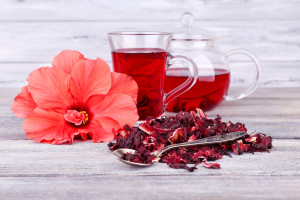Written by Greg Arnold, DC, CSCS. Supplementing with 2 grams of an antioxidant rich hibiscus powder for one month, saw significant improvements in total cholesterol, triglycerides, and LDL cholesterol levels in participating adolescents.
 Hibiscus sabdariffa is a plant found in tropical climates, including the Caribbean, Australia, Brazil, Central America, India, Africa, and the Philippines. It has gained popularity as a traditional medicine in helping with kidney stones and urinary bladder stones as well as a treatment for bacterial and fungal infections and helping maintain healthy blood pressure and cholesterol levels (1, 2).
Hibiscus sabdariffa is a plant found in tropical climates, including the Caribbean, Australia, Brazil, Central America, India, Africa, and the Philippines. It has gained popularity as a traditional medicine in helping with kidney stones and urinary bladder stones as well as a treatment for bacterial and fungal infections and helping maintain healthy blood pressure and cholesterol levels (1, 2).
Research has also started to suggest another use for Hibiscus sabdariffa — helping obese adolescents improve their lipid levels. A 2013 study (3) involved 72 obese adolescents (35 males, 37 females) aged 12 to 16, with an average body mass index of 25.38 kg/m2 and dyslipidemia. They received either 2 grams of fine powdered Hibiscus sabdariffa (36 subjects) or placebo (36 subjects) per day for one month. Subjects were instructed to follow their usual diet and exercise routines. Fasting blood samples were taken before and after the supplementation period.
The researchers classified “dyslipidemia” as the subjects having one of the following in levels greater than the 90th percentile of adolescents (triglycerides, total cholesterol, HDL cholesterol) or LDL cholesterol levels below the 10th percentile of adolescents. They also decided to focus on dyslipidemia as it has been shown to be “an important factor” in the onset of heart disease (4, 5).
After one month, the researchers found significant improvements in total cholesterol, LDL cholesterol, and triglycerides:
| Hibiscus | Placebo | p-value | |
|---|---|---|---|
| Total Cholesterol (mg/dL) | 5.6% decrease (186.5 to 176.11) | 1.1% decrease (200.6 to 198.5) | 0.003 |
| Triglycerides (mg/dL) | 8.1% decrease (146 to 134.22) | 1.7% decrease (166.16 to 163.44) | 0.022 |
| LDL Cholesterol (mg/dL) | 7.2% decrease (111.36 to 103.36) | 1.2% decrease (125.28 to 124.17) | < 0.001 |
Statistical significance was not reached with HDL cholesterol (p = 0.057).
When suggesting how Hibiscus sabdariffa may elicit these beneficial effects, researchers pointed to the high content of antioxidants called polyphenols, anthocyanins, flavonoids (6, 7) and went on to conclude that Hibiscus sabdariffa “can be considered for future studies on prevention and treatment of dyslipidemia and atherosclerotic disorders in adolescents.”
Source: Sabzghabaee, Ali Mohammad, Ehsan Ataei, Roya Kelishadi, Alireza Ghannadi, Rasool Soltani, Shirinsadat Badri, and Shahin Shirani. “Effect of Hibiscus sabdariffa calices on dyslipidemia in obese adolescents: a triple-masked randomized controlled trial.” Materia socio-medica 25, no. 2 (2013): 76.
© AVICENA 2013
Posted September 29, 2016.
Greg Arnold is a Chiropractic Physician practicing in Hauppauge, NY. You can contact Dr. Arnold directly by emailing him at PitchingDoc@msn.com or visiting his web site at www.PitchingDoc.com.
References:
- Mozaffari-Khosravi H, Jalali B, Afkhami-Ardakani M. Effect of Sour Tea (Hibiscus Sabdariffa) on Blood Glucose, Lipid Profile and Lipoproteins in Diabetics. Iranian Journal of Endocrinology and Metabolism. [Original]. 2009; 10(6): 589-597
- Mahadevan N, Shivali, Kamboj P. Hibiscus sabdariffa Linn.- an overview. Natural product radiance. 2008; 8(1): 77-83.
- Sabzghabaee AM Effect of Hibiscus sabdariffa Calices on Dyslipidemia in Obese Adolescents: A Triple-masked Randomized Controlled Trial. Mater Sociomed 2013;25(2):76-9. doi: 10.5455/msm.2013.25.76-79
- Lloyd-Jones D, Adams R, Carnethon M, De Simone G, Ferguson TB, Flegal K, et al. Heart disease and stroke statistics–2009 update: a report from the American Heart Association Statistics Committee and Stroke Statistics Subcommittee. Circulation. 2009; 119(3): 480-486
- Stepien E, Kablak-Ziembicka A, Musialek P, Tylko G, Przewlocki T. Fibrinogen and carotid intima media thickness determine fibrin density in different atherosclerosis extents. International Journal of Cardiology. 2012; 157(3): 411-413.
- Lin TL, Lin HH, Chen CC, Lin MC, Chou MC, Wang CJ. Hibiscus sabdariffa extract reduces serum cholesterol in men and women. Nutrition Research.2007; 27(3): 140-145
- Ali BH, Wabel NA, Blunden G. Phytochemical, Pharmacological and Toxicological Aspects of Hibiscus sabdariffa L. A Review. Phytotherapy research 2005; 19: 369-375.
